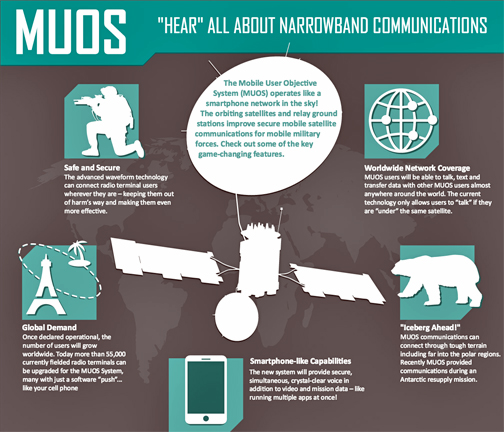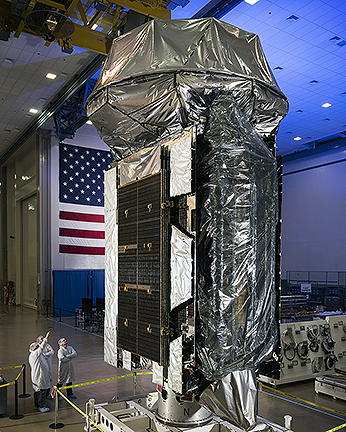
Marine Corps Systems Command is improving the way Marines communicate with a reliable and convenient on-the-move system.

MUOS infographic is courtesy of Lockheed Martin.
The Mobile User Objective System, or MUOS, is a narrowband satellite communication system that uses commercial cell phone technology to increase access to voice and data communication while on the battlefield. The Marine Corps will be the first service to widely deploy the system as it has already fielded thousands of MUOS-capable AN/PRC-117G radios over the previous six years. Ultimately, the firmware within the radios will be updated to support the MUOS waveform and three new antenna kits will be added to support multiple operational configurations.
MUOS is designed to support users who require mobility, higher data rates and improved operational availability. The updated technology in the system offers a more secure and reliable beyond line-of-sight communication capability. The MUOS waveform will be added to the AN/PRC-117G and future multi-channel radios within the Marine Corps inventory.
The three antenna kits that will be fielded within MUOS include: a traditional directional antenna for better data performance at-the-halt; a dismounted on-the-move antenna which enables voice and data access when mobile; and a vehicular kit that modifies the AN/VRC-114’s to accept MUOS.
MUOS is comprised of a space-based segment, a ground-based segment connected over fiber optic cables between multiple continents, and a software-defined radio terminal capable of running the MUOS waveform.
The new satellites are more robust and have more individual carriers, which allows the signal to be focused on a smaller geographic footprint, Avery said. This improvement enables on-the-move access while improving overall reliability in vegetation, urban environments and other extreme conditions where legacy SATCOM was challenged.
Additional improvements include the ability to roam, similar to a cell phone. Marines can begin in the continental United States, and then deploy and have immediate access to another satellite on the ground providing unmatched operational flexibility. Initial fielding for the MUOS is scheduled for the fourth quarter of 2018, with initial operational capability planned for the first quarter of 2019.
Captain Shawn Avery, MUOS project officer in Command Element Systems at MCSC, said that MUOS provides several advantages over legacy SATCOM. The most obvious to the operating forces will be the increased accessibility. This will allow for the exploration of new operating concepts by pushing on-the-move voice and data connectivity to the squad level. Previously, infantry companies had limited access to SATCOM, but now company commanders can employ their Marines beyond line of sight with a higher degree of confidence in maintaining those critical [command and control] links.
He added that the system takes some stress off of the operators, allowing them to walk around on patrol without the range constraints of terrestrial networks. In the past, users didn’t have access to the Defense Information System Network over SATCOM. Terrain had to be held in order to extend terrestrial links to provide DISN access, which incurs significant operational risk, or commercial capabilities had to be leased, which have proven costly. With MUOS, the data exchange requirements of today’s force are being met with equipment that is organic to the Marine Air-Ground Task Force.
Back in November of 2017, the U.S. Navy's Communications Satellite Program Office, PMW 146, and Lockheed Martin (NYSE: LMT) handed over full operational control of the fifth Mobile User Objective System (MUOS) satellite to the Naval Satellite Operations Center (NAVSOC).

The MUOS-5 satellite upon completion of manufacturing.
Photo is courtesy of Lockheed Martin.
The earlier October 11 milestone followed the successful completion of the MUOS-5 satellite's on orbit testing and delivery of all operational products needed to "fly" the satellite. In April of 2017, the U.S. Navy, working with Army Forces Strategic Command (ARSTRAT), configured one of MUOS-5's two communications payloads — its legacy Ultra High Frequency (UHF) payload — for testing.
The handover of this satellite to NAVSOC cleared the final hurdle and allowed for ARSTRAT to provide the payload's final configurations to support the Navy's legacy UHF satellite communications mission.
Mark Woempner, Lockheed Martin's director for Narrowband Communications, said that ARSTRAT's final configuration of MUOS-5's UHF legacy payload allows the satellite to fully support U.S. military forces in these Combatant Commands.
Eventually, legacy narrowband UHF communications will transition to next generation Wideband Code Division Multiple Access (WCDMA) capabilities. To facilitate that transition, all five on orbit MUOS satellites were intentionally designed with two communications payloads to support both Legacy UHF and WCDMA.
Early combatant commander testing of the on-orbit WCDMA payloads began in July 2016. The new MUOS capabilities will revolutionize communications for mobile forces with simultaneous, crystal-clear voice, video and mission data over a secure high-speed Internet Protocol-based system. Users with new MUOS terminals will be able to seamlessly connect beyond line-of-sight around the world and into the Global Information Grid, as well as into the Defense Switched Network, as part of the Navy's worldwide cellular network.
Once fully operational, the MUOS network of five on orbit satellites and four relay ground stations will provide more than 10 times the communications capacity of the legacy UHF satellite system. MUOS' network already provides near-global coverage, including communications into polar regions. MUOS also has demonstrated successful communication of Integrated Broadcast Service (IBS) messages.
There are more than 55,000 radio terminals currently fielded that can be upgraded to be MUOS-compatible, with many of them requiring just a software upgrade.
The Navy's Program Executive Office for Space Systems and its Communications Satellite Program Office responsible for the MUOS program are based in San Diego, California. Lockheed Martin assembled and tested all five now on orbit MUOS satellites at its Sunnyvale, California, facility.

